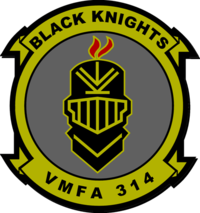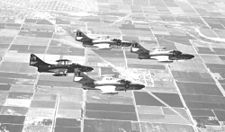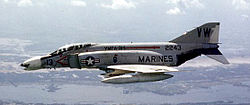- VMFA-314
-
Marine Fighter Attack Squadron 314 
VMFA-314 InsigniaActive - October 1, 1943 – April 30, 1947
- February 1, 1952 – present
Country United States Allegiance United States of America Branch United States Marine Corps Type Fighter/Attack Role Close air support
Air interdiction
Aerial reconnaissancePart of Marine Aircraft Group 11
3rd Marine Aircraft WingGarrison/HQ Marine Corps Air Station Miramar Nickname Black Knights
Bob's Cats (World War II)Tail Code VW / NG Engagements World War II
* Battle of Okinawa
Vietnam War
Operation Desert Storm
Operation Enduring Freedom
Operation Iraqi FreedomCommanders Current
commanderLtCol David A. Kalinske Aircraft flown Fighter F4U Corsair
F9F Panther
F4D Skyray
F-4 Phantom II
F/A-18 HornetMarine Fighter Attack Squadron 314 (VMFA-314) is a United States Marine Corps F/A-18 Hornet squadron. The squadron, known as the "Black Knights", is based at Marine Corps Air Station Miramar, California and falls under the command of Marine Aircraft Group 11 (MAG-11) and the 3rd Marine Aircraft Wing (3d MAW). Their tail code is VW.
Contents
History
World War II
Marine Fighting Squadron 314 (VMF-314) was commissioned on October 1, 1943 at Marine Corps Air Station Cherry Point, North Carolina. The squadron was originally given the nickname of, "Bob's Cats"[1]. The squadron was assigned to Marine Aircraft Group 32 (MAG 32) flying the F4U Corsair and began training immediately for combat in the South Pacific. In February 1944, the squadron, along with VMF-324, was among the first units aboard Marine Corps Auxiliary Air Field Kinston[2]. They left MCAAF Kinston for the Pacific theater and arrived at Marine Corps Air Station Ewa on June 18, 1944 and were reassigned to Marine Aircraft Group 23, 3rd MAW[3]. From there they deployed to Midway Atoll.
VMF-314 returned to MCAS Ewa in December 1944 and remained there until April 1945, when they moved to Ie Shima in May 1945 to take part in the Battle of Okinawa[3] as part of Marine Aircraft Group 22 (MAG-22)[4]. During the ensuing campaign, VMF-314 pilots were credited with 11 kills[5] and the squadron was awarded the Presidential Unit Citation[6]. After the surrender of Japan, VMF-314 moved to Kyūshū, Japan as part of the occupation force. VMF-314 returned to Marine Corps Air Station El Toro in November 1945 and in March 1946 they arrived back at MCAS Cherry Point. For a short time they were re-assigned to Marine Aircraft Group 22 (MAG-22), 9th Marine Aircraft Wing but were decommissioned on April 30, 1947[1].
Post-war years
VMF-314 was re-commissioned in 1952 at Marine Corps Air Station Miami, Florida and was assigned to Marine Aircraft Group 31 (MAG-31), 3rd Marine Aircraft Wing flying the latest version of the Corsair. That same year, the squadron transitioned to the new F9F Panther. The next three years saw VMF-314 deployed twice, first to Roosevelt Roads, Puerto Rico, and then to Naval Air Facility Atsugi, Japan for an 18-month tour. VMF-314 earned the Korean Service Medal for operations conducted between September 11, 1953 and July 27, 1954.[7] In 1955, VMF-314 returned from Japan and was assigned to Marine Aircraft Group 15, 3rd MAW, now stationed at Marine Corps Air Station El Toro, California.
In 1957, the squadron received the new F4D Skyray and was designated VMF(AW)-314. During that same year, the squadron officially became the "Black Knights", was awarded the Commandant’s Aviation Efficiency Trophy. They were briefly deployed to NAF Atsugi, Japan and then throughout the Far East both on land, including Ping-tung, Taiwan in support of the Chinese Nationalist Party against the communists, as well as on board the fast attack carriers USS Hancock (CV-19) and USS Ticonderoga (CV-14).
In 1961, the squadron became the first Marine squadron to transition to the new F-4B Phantom II and was designated VMFA-314. Between 1961 and 1964, the squadron deployed eight times. These included three separate carrier deployments and a single-flight aerial refueling mission spanning the Pacific Ocean from MCAS El Toro to Naval Air Station Atsugi, Japan.
Vietnam War
In 1965, VMFA-314 headed off on board the USS Valley Forge (CV-45) for combat operations in the Republic of Vietnam. From 1965 to 1970, the squadron flew more than 25,000 combat hours out of Chu Lai and Da Nang airfields, and employed more than 100 million pounds of ordnance in support of the Marine rifleman and other Allied ground units. In 1968, they received the Chief of Naval Operations Aviation Safety Award. In 1969, VMFA–314 was awarded the Hanson Trophy as the best Fighter Attack Squadron in the Marine Corps. The Commandant’s Efficiency Trophy was awarded to the squadron in 1969 and again in 1970. In September 1970, VMFA-314 ended forty-nine months of deployed combat operations and received the Meritorious Unit Commendation for its outstanding performance.
Post-Vietnam years
In May 1982, the squadron’s last F-4 was transferred in preparation for transition to the new F/A-18 Hornet. In 1982, VMFA-314 received the first of its F/A-18s, becoming the first tactical squadron in the Marine Corps and Navy to employ the Hornet.
In 1985, VMFA-314 transferred to Carrier Air Wing 13 (CVW-13), and embarked on board the USS Coral Sea (CV-43) for duty with the Sixth Fleet in the Mediterranean Sea. They participated in Freedom of Navigation operations in the vicinity of Libya and took part in combat operations in support of Operation El Dorado Canyon in the Gulf of Sidra and in Libya.
The Gulf War and the 1990s
In the Summer of 1990, while preparing to return to the Western Pacific, the squadron were rapidly deployed to the Persian Gulf and were the first Marine F/A-18 squadron to arrive in Bahrain for Operation Desert Shield as part of Marine Air Group 70. For nearly six months the "Black Knights" maintained 24 hour a day Combat Air Patrols over the Persian Gulf.
On January 16, 1991, Operation Desert Shield shifted to Operation Desert Storm. The squadron flew over 1,500 hours and 814 combat sorties, more sorties than any other Navy or Marine Corps squadron. Missions flown during the war included Escort, SEAD, Mig Sweep, and Strike. They returned from the Middle East in March 1991 without the loss of a single squadron member or aircraft.
In August 1992, VMFA-314 transferred to Carrier Air Wing 11 and in 1993 deployed to the Indian Ocean and Persian Gulf on board the USS Abraham Lincoln. During the deployment the squadron participated in Operation Southern Watch, enforcing the UN “no-fly-zone” in southern Iraq, and in Operation Continue Hope, providing close air support to the 13th Marine Expeditionary Unit (13th MEU) and 22nd Marine Expeditionary Unit (22nd MEU) off the coast of Somalia. The squadron returned from cruise in December 1993 and was reassigned to Marine Aircraft Group 11 (MAG-11).
In June 1994, VMFA-314 was one of the first MAG-11 squadrons to move from MCAS El Toro to Marine Corps Air Station Miramar. In February 1996, the squadron received new lot 18 F/A-18C aircraft. In 1997, VMFA-314 transferred to Carrier Air Wing 9 and deployed on an “Around the World” cruise on board the USS Nimitz. During the deployment, the squadron again participated in Operation Southern Watch.
In January 2000 the squadron deployed aboard the USS John C. Stennis, with Carrier Air Wing Nine, for a six month deployment to the Western Pacific and Persian Gulf in support of Operation Southern Watch. While in the Gulf, the "Black Knights" flew contingency operations under combat conditions in support of UN Resolutions, delivering accurate air-to-ground ordnance under hostile fire.
Global War on Terror
VMFA-314 was called upon to deploy Marines and aircraft on board the USS John C. Stennis (CVN-74) in support of Operation Noble Eagle. The attacks on September 11, 2001 caused the planned deployment on board the Stennis to be accelerated by two months. Following a shortened at-sea period for FleetEx, VMFA-314 deployed on November 12, 2001 in support of Operation Enduring Freedom. The squadron began flying combat sorties on December 18, 2001 and delivered over 69,000 pounds of ordnance in support of U.S. forces on the ground in Afghanistan. Midway into a six-month deployment, VMFA-314 was extended in theater an extra five weeks resulting in a monumental 265 deployed days over a year’s period including a 98-day straight at-sea period.
The squadron deployed to Iraq in support of Operation Iraqi Freedom in March 2009. They were based at Al Asad Airbase and returned in September of 2009.[8]
Awards
 Presidential Unit Citation with two Bronze Stars
Presidential Unit Citation with two Bronze Stars Navy Unit Commendation with four Bronze Stars
Navy Unit Commendation with four Bronze Stars Meritorious Unit Citation Streamer with one Bronze Star.
Meritorious Unit Citation Streamer with one Bronze Star.
In pop culture
- In the science fiction film Independence Day (1996), Will Smith plays a Marine Corps pilot from VMFA-314, Captain Steven Hiller, stationed at MCAS El Toro. In the movie, the squadron led the first counterattack against the alien forces but was severely defeated, while the air base was destroyed.
- In the action film The Rock (1996), the F/A-18 fighters rate the insignia of VMFA-314, however, in front of the left intake, "U.S. Air Force" can be seen clearly.
See also
- United States Marine Corps Aviation
- List of active United States Marine Corps aircraft squadrons
- List of inactive United States Marine Corps aircraft squadrons
- VMM-264 US Marine Corp Medium helicopter squadron of the same namesake
- VFA-154 US Navy Fighter attack squadron of the same namesake
- RSAF Black Knights Republic of Singapore Air Force precision aerobatic team of the same namesake
Notes
- ^ a b Rottman ‘’U.S. Marine Corps World War II OOB’’, pg. 443.
- ^ Shettle USMC Air Station of WWII, pg. 101.
- ^ a b Sherrod ‘’History of Marine Aviation in WWII’’, pg. 467.
- ^ Sherrod ‘’History of Marine Aviation in WWII’’, pg. 372.
- ^ Sherrod ‘’History of Marine Aviation in WWII’’, pg. 431.
- ^ Sherrod ‘’History of Marine Aviation in WWII’’, pg. 427.
- ^ "The Korean Service Medal 1950-1954, U.S. Marine Corps Units". Service Medals & Campaign Credits of the United States Navy. Naval Historical Center, Department of the Navy. February 28, 2001. http://www.history.navy.mil/medals/kormedal/korusmc.htm.
- ^ Black Knights Fight for the Commander's Cup
References
 This article incorporates public domain material from websites or documents of the United States Marine Corps.
This article incorporates public domain material from websites or documents of the United States Marine Corps.
- Bibliography
- Crowder, Michael J. (2000). United States Marine Corps Aviation Squadron Lineage, Insignia & History - Volume One - The Fighter Squadrons. Turner Publishing Company. ISBN 1-56311-926-9.
- Rottman, Gordon L. (2002). U.S. Marine Corps World War II Order of Battle - Ground and Air Units in the Pacific War, 1939 - 1945.’’. Greenwood Press. ISBN 0-313-31906-5.
- Sherrod, Robert (1952). History of Marine Corps Aviation in World War II. Washington, D.C.: Combat Forces Press.
- Shettle Jr., M. L. (2001). United States Marine Corps Air Stations of World War II. Bowersville, Georgia: Schaertel Publishing Co.. ISBN 0-964-33882-3.
- Web
MAG-11 
MAG-13 MAG-16 MAG-39 MACG-38 MWSG-37 Categories:- United States Marine Corps fixed wing squadrons
Wikimedia Foundation. 2010.






